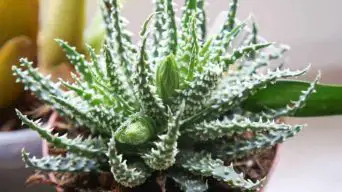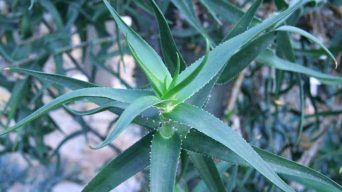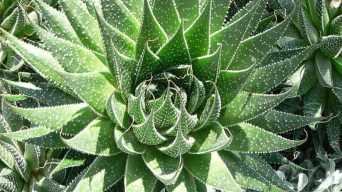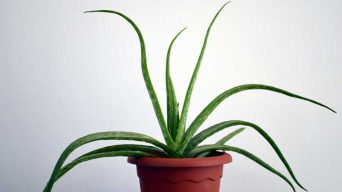The Aloe plicatilis is an easy-to-care-for succulent that will thrive in any environment. It’s also one of the most beautiful plants you’ll find!
With its large leaves and clusters of orange flowers, this plant will make your home or garden feel more alive and vibrant.
Learn how to propagate and care for the Aloe plicatilis (Fan Aloe). This guide will cover all you need to know to keep your plant healthy for years!
Overview
| Family: | Asphodelaceae |
| Genus: | Kumara |
| Botanical Name: | Kumara plicatilis |
| Synonyms: | Aloe plicatilis |
| Common Names: | Fan Aloe |
| Origin: | Western Cape, South Africa |
| USDA Hardiness Zones: | 9 – 12 |
| Size: | 4 to 8 feet (120-240 cm) tall and 4 to 6 feet (120-180 cm) wide |
| Sun Exposure: | Full sun to partial shade |
| Water Needs: | Water thoroughly but infrequently |
| Soil Type: | Well-draining soil |
| Temperature: | 68° – 80° F (20 – 27°C) |
| Humidity Levels: | 40-50% |
Aloe plicatilis, commonly known as the Fan Aloe, is an Aloe species from the Asphodelaceae family native to Cape Province in South Africa.
It is a large succulent that reaches heights of up to 8 feet (240cm).
The leaves of the Aloe plicatilis plant can grow up to 12 inches (30cm) long and two inches (5cm) wide, arranged in fans at the end of their stems.
This pale green succulent has flattened, fleshy leaves with no spines except for some tiny teeth at the tips.
Each leaf fan produces a cluster of two-inch (5 cm) long tubular orange to red flowers during fall and winter.
How To Care for Aloe Plicatilis ‘Fan Aloe’
Aloe plicatilis care is straightforward and easy. You need to know what you are doing and be patient.
Below you’ll find the essential information you need to know about caring for Aloe plicatilis (Fan Aloe).
Sun Exposure & Light Requirements
The Aloe plicatilis (Fan Aloe) succulent plant hails from mountainous or semi-desert regions of southern Africa. These plants are accustomed to bright indirect light, and you should treat your Aloe similarly.
Aloes prefer full sun to partial shade-they grow outside under a tree with varying amounts of afternoon shade, but you can also grow them indoors.
Indoors, you can keep your Aloe near a southern or southwest-facing window with plenty of bright, indirect light. This will ensure the plant is well lit without drying it out.
The ideal location for an Aloe is near a large window where it will receive plenty of light without being harmed by the hot rays of direct sun during midday.
When grown outdoors, provide light shade during the hottest part of the day, especially if you live in a very sunny climate. Aloes will also tolerate light shade while growing outside during the winter months.
Offer your Aloe plicatilis (Fan Aloe) a location with partial sun or bright, indirect light. These succulents will thrive outdoors in full sun once they are acclimated to warm weather.
Watering Requirements
You should water succulent Aloe plicatilis (Fan Aloe) plants about once a week. Overwatering can kill your plant, so allow the soil to dry out before you water it.
Avoid overwatering your plant because this will cause root rot. If you overwater your plant, you will kill it because you are causing root rot.
An excellent way to tell if your plant needs more water is if you touch the soil and it feels dry, you should water it.
If your plant has signs of wilting, you should water it immediately.
The best time to water your plant is in the morning.
When watering, you should use an irrigation or drip can until the water comes out of the drainage holes.
We recommend you water less during the winter since they typically grow slower during this time.
Soil Requirements
The Aloe plicatilis (Fan Aloe) succulent plant needs a well-draining soil like a cactus or succulent soil mix.
You can create your own mix, or you can choose to buy one.
The optimal soil for the Aloe plicatilis (Fan Aloe) is a mixture of sand and potting soil with some perlite, vermiculite, peat moss, and sharp sand added in.
A succulent soil mix is also a good choice.
However, you can use whatever you have at your disposal. Just make sure it drains well and provides the proper nutrients to your plant.
Temperature and Humidity
Aloe plicatilis (Fan Aloe) needs a temperature range of 68° – 80° Fahrenheit (20 – 27°C).
During the day, you may set the temperature between 68° – 80°F, while at night, you will want to set the temperature between 60° – 70 °F.
The ideal relative humidity for this plant is 40% or higher during the day and 30% or lower during the nighttime hours.
Too much humidity will cause the plant to rot. Lowering the humidity by increasing air circulation or opening the windows would be best.
Fertilizing
Aloe plicatilis (Fan Aloe) does not have to be fertilized.
If you decide to do it, you will need to fertilize it only in the growing season and with a diluted fertilizer at half strength.
If you fertilize, don’t overdo it, you can burn the plant if you use too much.
Potting and Repotting
Aloe plicatilis (Fan Aloe) succulents are slow-growing plants that you may not need to repot if you take care of them correctly.
Repot the plant in the spring after you see new leaves forming. Choose a container only 1 or 2 inches (2.5 to 5 cm) larger than its current one, and make sure it has drainage holes. Mix equal parts of potting soil and coarse sand or pebbles to add more drainage.
If you want your plant to grow faster, you should repot it every two years. Remove any yellow leaves you see reaching down to the soil.
You mustn’t damage your plant roots when repotting them, so be extra careful.
Pruning
Aloe plicatilis (Fan Aloe) is an easy-to-grow type of Aloe. You do not have to prune this plant because it does not develop branches or grow bushy.
You only need to remove dead leaves or old stems if you notice them.
However, you will need to be careful with the edges of the leaf that you prune.
You should try not to damage the soft inner fleshy layer when you cut off the leaf’s dead part.
Pests and Diseases
Some common pests and diseases that you might find on your Aloe plicatilis (Fan Aloes) are:
- Slugs – These can be easily found by the slime trails they leave. They can be removed by hand, or you could use insecticidal soap diluted in water and spray the leaves of your plant to kill the slugs you see.
- Aphids – You might notice a sticky cluster of aphids feeding on your Aloe plicatilis leaves. You could spray insecticidal soap diluted in water on them or remove them carefully with a cotton swab dipped in alcohol.
- Mealybugs – You could find white cotton-looking dots on your plant’s roots and see the mealybugs walking around if you observe closely enough. You can use insecticidal soap diluted in water to kill them off.
- Root rot – You can find your Aloe plicatilis (Fan Aloe) plants drooping, and you won’t see much new growth. You should repot the plant you suspect to have this problem in a well-drained potting medium with plenty of air circulation.
How to Care for Aloe Plicatilis (Fan Aloe) in Winter
Aloe plicatilis (Fan Aloe Plant) is not a cold-hardy plant. This means you cannot leave your Fan Aloe outside during winter when the temperatures are below 50 degrees Fahrenheit.
During winter, you must move your Fan Aloe into a warmer climate or grow it indoors under the proper conditions.
If you live in an area without worrying about harsh weather, you can leave your Fan Aloe outside and let it grow on its own.
When you overwinter your Fan Aloe, keep it outside for as long as possible.
The longer you wait, the more stress your Aloe plicatilis succulent plant will go through.
You should move your plant outdoors in the spring or early summer and allow it to acclimate itself naturally.
How To Propagate Aloe Plicatilis (Fan Aloe)
Aloe plicatilis (Fan Aloe) is an easy succulent plant to propagate. It can be propagated by cuttings or seeds.
Propagate From Cuttings
Aloe plicatilis (Fan Aloe) cuttings are easy to root. This succulent plant is best propagated by stem cuttings.
Cut a stem or branch. The stem you take for the cutting should be soft and pliable.
Place the cutting you have taken in lightly moistened vermiculite to allow it to callus for several days before you plant it in a well-drained soil mixture.
Allow the soil you use to dry out between waterings.
This succulent plant does best in full sun, with only occasional watering. It needs very little water and care.
Propagate From Seeds
Sow seeds on top of a lightly moistened seed starting mix after cleaning them and removing the pulp from your Aloe plicatilis (Fan Aloe) seeds.
Place them in a warm location at room temperature. You will see the seedling emerge from the soil in about 3 to 7 days.
Gently water your newly germinated succulent plant until it is well established. Then you can water it as you would any other succulent plant you have.
In a couple of months, you should be able to transplant your Aloe plicatilis (Fan Aloe) seedlings into individual containers filled with cactus potting soil or your regular well-draining succulent houseplant soil mix.
Is the Aloe Plicatilis (Fan Aloe) Toxic?
The Aloe Plicatilis (Fan Aloe) is not toxic to you, your pets, or other animals.
However, you should know that some people are allergic to succulent plants.
If you notice your skin burning or itching after you touch the leaves of this plant, you might be allergic to it, and you should refrain from touching the succulent leaves in the future.
Final Thoughts
If you’re looking for a new plant for your home or garden this year, consider adding Aloe plicatilis as one of your options!
They’re easy-to-care-for plants with beautiful foliage that will add color to your space all year round. And don’t forget about the flowers too!








I have a large aloe plicitelis thatj is in a pot that the wind knocked over what are my options
Hi Marilyn.
When assessing the damage of an Aloe Plicatilis that has been knocked over, it is important to check the plant carefully and remove any dead or damaged leaves using a sharp blade.
To help restore the plant, it may be beneficial to repot it in new soil and provide extra care and attention.
Additionally, it is essential to ensure that the plant is firmly entrenched in its pot. If the pot is unsuitable for this purpose, transferring the plant into a larger, more stable container with deeper soil may be necessary.
Furthermore, one can add stakes or other supports around the pot and surrounding soil for enhanced stability and protection from further wind damage.
Hello!! Anybody have a fan aloe that I can prune and shape?? I would love too! And keep some cuttings!! Thank you! lynn